1997 BUICK REGAL air condition
[x] Cancel search: air conditionPage 165 of 422
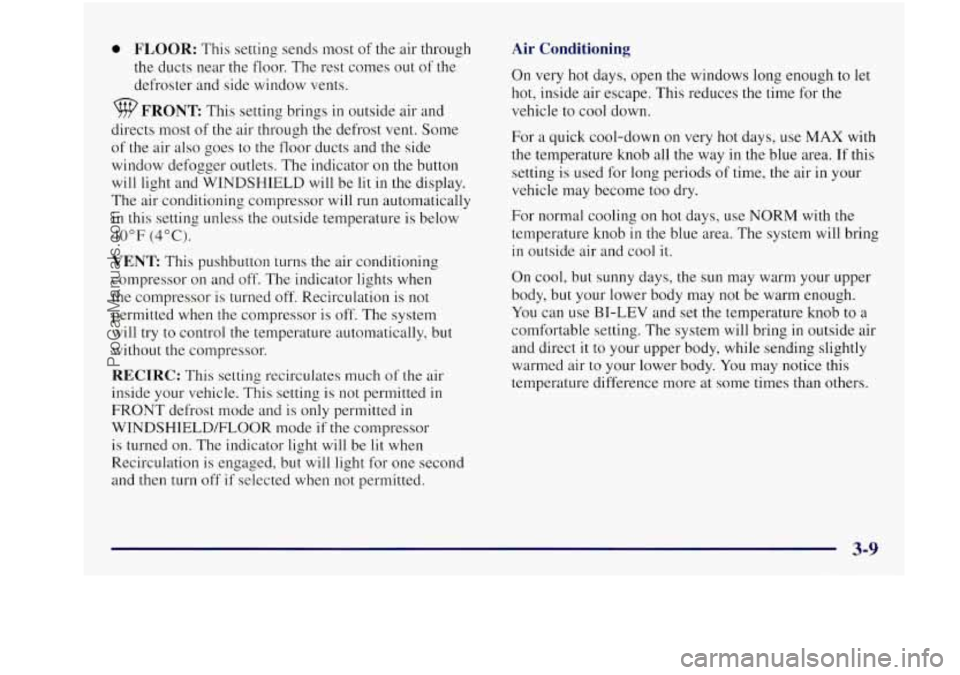
0 FLOOR: This setting sends most of the air through
the ducts near the floor. The rest comes out
of the
defroster and side window vents.
WFRONT This setting brings in outside air and
directs most of the air through the defrost vent. Some
of the air also goes to the floor ducts and the side
window defogger outlets. The indicator on the button
will light and WINDSHIELD will be lit in the display.
The air conditioning compressor will run automatically
in this setting unless the outside temperature is below
40°F (4°C).
VENT: This pushbutton turns the air conditioning
compressor on and off. The indicator lights when
the compressor is turned off. Recirculation is not
permitted when
the compressor is off. The system
will try to control the temperature automatically, but
without the compressor.
RECIRC: This setting recirculates much of the air
inside your ve.hicle. This setting is not permitted
in
FRONT defrost mode and is only permitted in
WINDSHIELD/FLOOR mode if the compressor
is turned on. The indicator light will be lit when
Recirculation is engaged, but will light for one second
and then turn
off if selected when not permitted.
Air Conditioning
On very hot days, open the windows long enough to let
hot, inside air escape. This reduces the time for the
vehicle to cool down.
For
a quick cool-down on very hot days, use MAX with
the temperature knob all
the way in the blue area. If this
setting
is used for long periods of time, the air in your
vehicle may become too dry.
For normal cooling on hot days, use NORM with
the
temperature knob in the blue area. The system will bring
in outside air and cool it.
On cool, but sunny days, the sun may warm your upper
body, but your lower body may not be warm enough.
You can use BI-LEV and set the temperature knob to a
comfortable setting. The system will bring in outside air
and direct it to your upper body, while sending slightly
warmed air to your lower body.
You may notice this
temperature difference more at some times than others.
3-9
ProCarManuals.com
Page 166 of 422
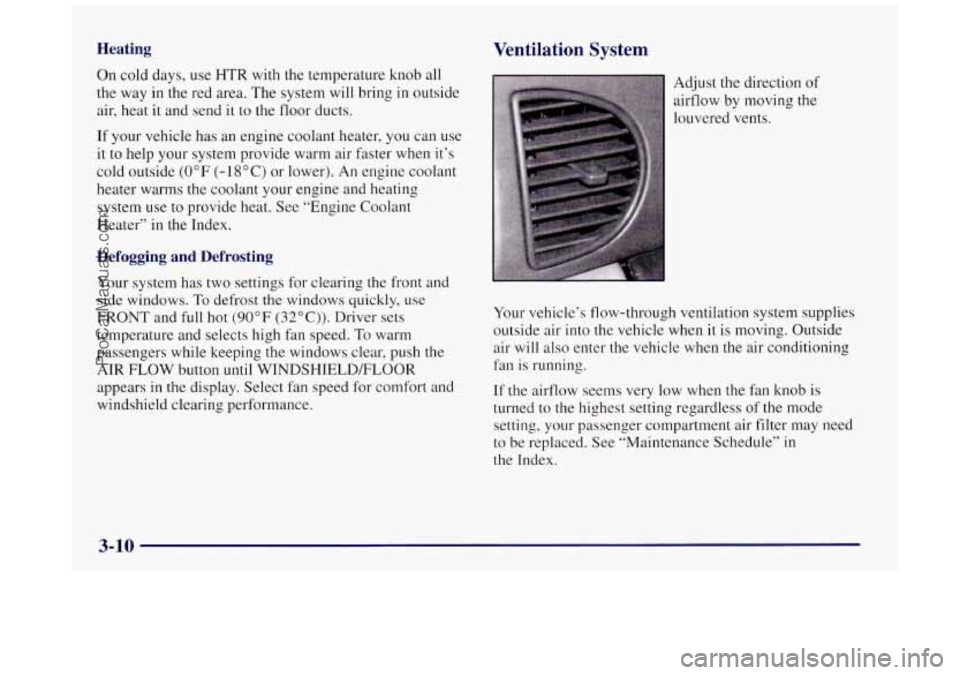
Heating
On cold days, use HTR with the temperature knob all
the way in the red area. The system will bring in outside
air, heat it and send it to the floor ducts.
Ventilation System
If your vehicle has an engine coolant heater, you can use
it to help your system provide warm air faster when it’s
cold outside
(0°F (-18°C) or lower). An engine coolant
heater warms the coolant your engine and heating
system use to provide heat. See “Engine Coolant
Heater” in
the Index.
Defogging and Defrosting
Your system has two settings for clearing the front and
side windows.
To defrost the windows quickly, use
FRONT and full hot
(90°F (32°C)). Driver sets
temperature and selects high fan speed.
To warm
passengers while keeping the windows clear, push the
AIR FLOW button until WINDSHTELDFLOOR
appears
in the display. Select fan speed for comfort and
windshield clearing performance. Adjust the direction
of
airflow by moving the
louvered vents.
Your vehicle’s flow-through ventilation system supplies
outside air into the vehicle when
it is moving. Outside
air will also enter the vehicle when the
air conditioning
fan is running.
If the airflow seems very low when the fan knob is
turned to the highest setting regardless of
the mode
setting, your passenger compartment air filter may need
to be replaced. See “Maintenance Schedule” in
the Index.
3-10
ProCarManuals.com
Page 213 of 422
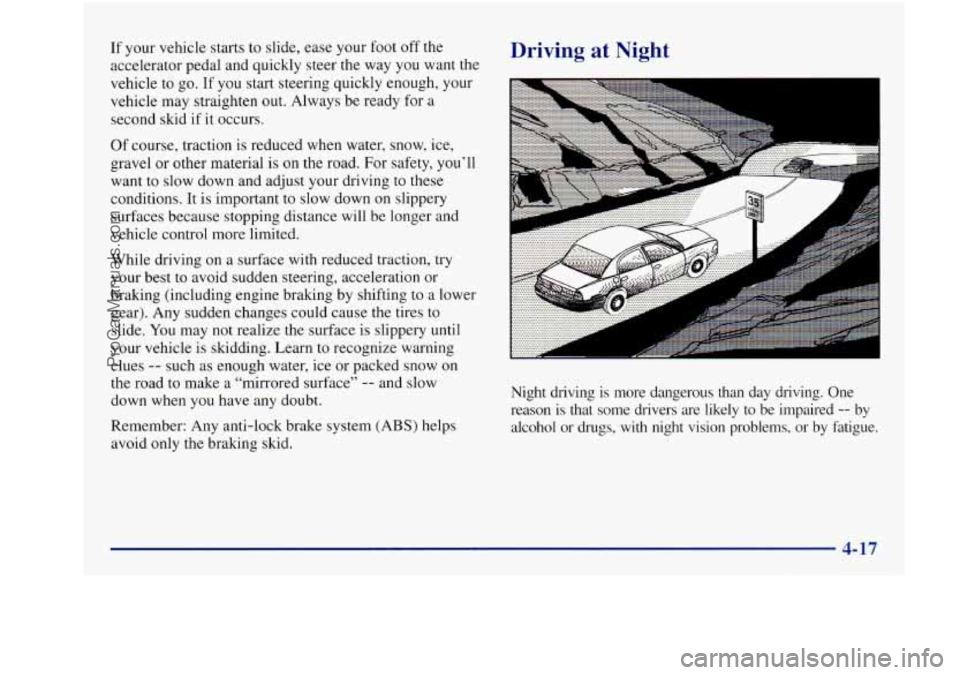
If your vehicle starts to slide, ease your foot off the
accelerator pedal and quickly steer the way you want the
vehicle to go.
If you start steering quickly enough, your
vehicle may straighten
out. Always be ready for a
second skid
if it occurs.
Of course, traction is reduced when water, snow, ice,
gravel or other material is
on the road. For safety, you’ll
want to slow down and adjust your driving to these
conditions. It is important to slow down on slippery
surfaces because stopping distance will be longer and
vehicle control more limited.
While driving on a surface with reduced traction, try
your best
to avoid sudden steering, acceleration or
braking (including engine braking by shifting to a lower
gear). Any sudden changes could cause the tires to
slide. You may not realize the surface
is slippery until
your vehicle is skidding. Learn
to recognize warning
clues
-- such as enough water, ice or packed snow on
the road to make a “mirrored surface’’
-- and slow
down when you have any doubt.
Remember: Any anti-lock brake system (ABS) helps
avoid only the braking skid.
Driving at Night
/’ ,//
..... ....A
A
A
Night driving is more dangerous than day driving. One
reason is that
some drivers are likely to be impaired -- by
alcohol or drugs, with night vision problems, or by fatigue.
ProCarManuals.com
Page 252 of 422
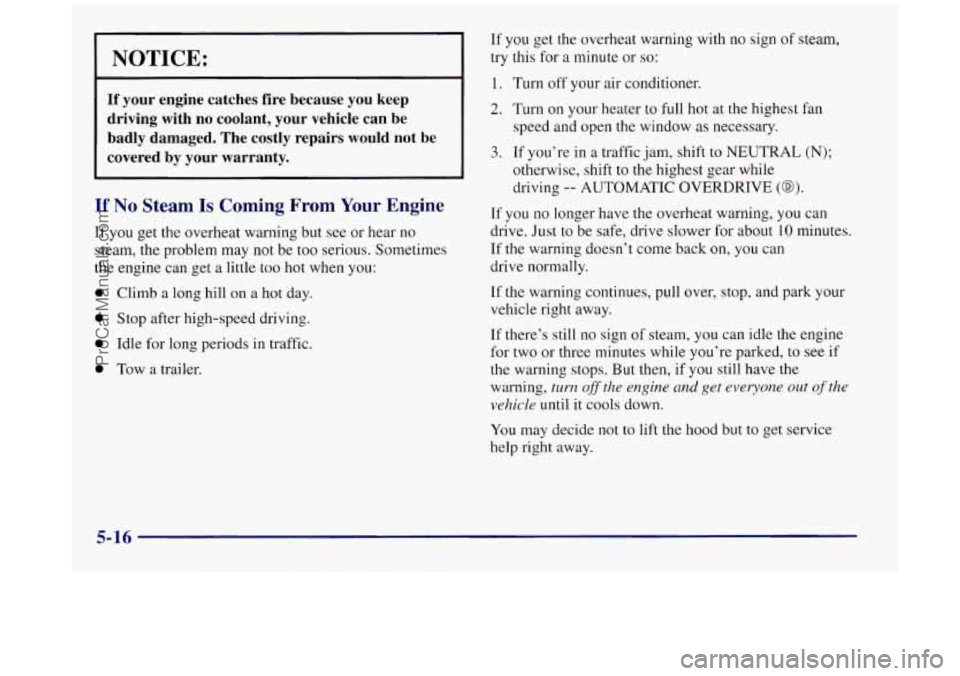
1 NOTICE:
I I
If your engine catches fire because you keep
driving with no coolant, your vehicle can
be
badly damaged. The costly repairs would not be
covered by your warranty.
If No Steam Is Coming From Your Engine
If you get the overheat warning but see or hear no
steam, the problem may not be too serious. Sometimes
the engine can get a little too hot when you:
0 Climb a long hill on a hot day.
0 Stop after high-speed driving.
0 Idle for long periods in traffic.
0 Tow a trailer. If you
get the overheat warning with no sign of steam,
try this for
a minute or so:
1. Turn off your air conditioner.
2. Turn on your heater to full hot at the highest fan
speed and open the window as necessary.
3. If you’re in a traffic jam, shift to NEUTRAL (N);
otherwise, shift to the highest gear while
driving
-- AUTOMATIC OVERDRIVE (@).
If you no longer have the overheat warning, you can
drive. Just to be safe, drive slower
for about 10 minutes.
If the warning doesn’t come back
on, you can
drive normally.
If the warning continues, pull over, stop, and park your
vehicle right away.
If there’s still no sign of steam, you can idle the engine
for two or three minutes while you’re parked, to see if
the warning stops. But then, if you still have the
warning, turn ofthe engine
and get everyone out of the
vehicle until it cools down.
You may decide not to lift the hood but to get service
help right away.
5-16
ProCarManuals.com
Page 277 of 422
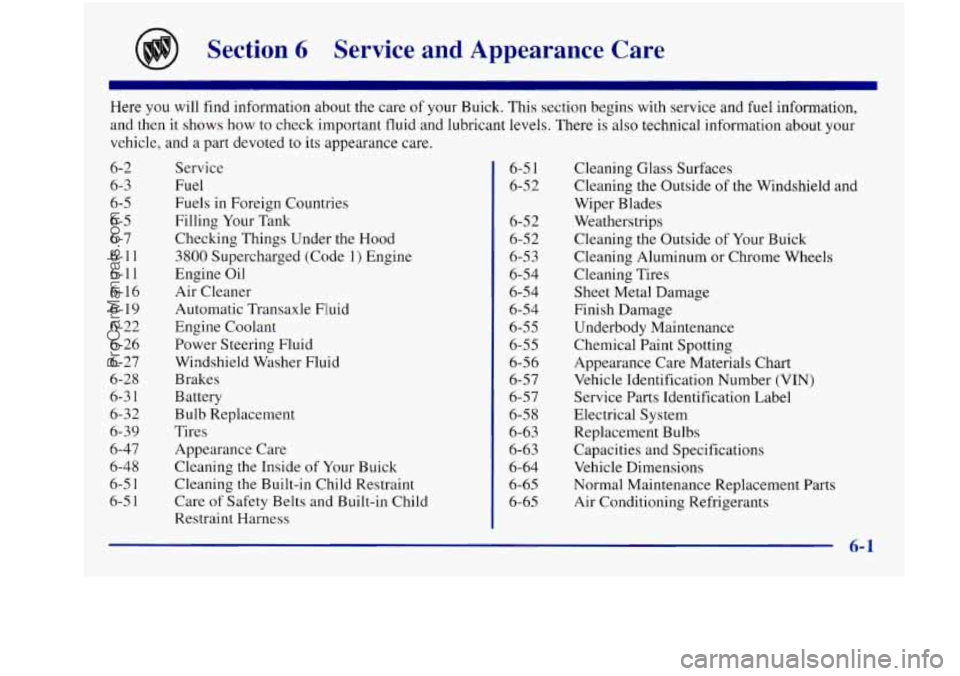
Section 6 Service and Appearance Care
Here you will find information about the care of your Buick. This section begins with service and fuel information,
and then it shows how
to check important fluid and lubricant levels. There is also technical information about your
6-2
6-3
6-5
6-5
6-7
6-11
6-1
1
6-16
6-19
6-22
6-26
6-27
6-28
6-3
1
6-32 6-39
6-47
6-48
6-5
1
6-5 1
vehicle, and a part devoted to its appearance care.
Service
Fuel
Fuels in Foreign Countries
Filling Your Tank
Checking Things Under the Hood
3800 Supercharged (Code 1) Engine
Engine Oil
Air Cleaner
Automatic Transaxle Fluid
Engine Coolant
Power Steering Fluid
Windshield Washer Fluid
Brakes
Battery
Bulb Replacement
Tires
Appearance Care
Cleaning the Inside
of Your Buick
Cleaning the Built-in Child Restraint
Care
of Safety Belts and Built-in Child
Restraint Harness 6-5
1
6-52
6-52
6-52
6-53
6-54 6-54
6-54
6-55
6-55
6-5 6
6-57
6-57
6-58
6-63
6-63
6-64
6-65
6-65 Cleaning Glass Surfaces
Cleaning
the Outside of the Windshield and
Wiper Blades
Weatherstrips Cleaning the Outside of Your Buick
Cleaning Aluminum or Chrome Wheels
Cleaning Tires
Sheet Metal Damage
Finish Damage
Underbody Maintenance
Chemical Paint Spotting
Appearance Care Materials Chart
Vehicle Identification Number
(VIN)
Service Parts Identification Label
Electrical System Replacement Bulbs
Capacities and Specifications
Vehicle Dimensions
Normal Maintenance Replacement Parts
Air Conditioning Refrigerants
6-1
ProCarManuals.com
Page 280 of 422
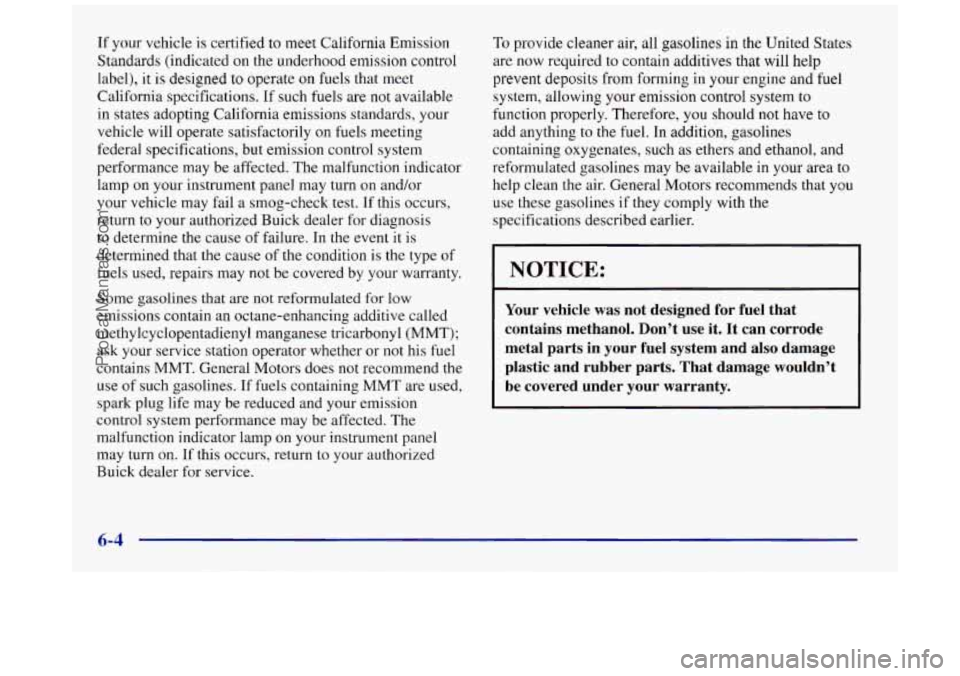
If your vehicle is certified to meet California Emission
Standards (indicated on the underhood emission control
label), it
is designed to operate on fuels that meet
California specifications. If such fuels are not available
in states adopting California emissions standards, your
vehicle will operate satisfactorily on fuels meeting
federal specifications, but emission control system
performance may be affected. The malfunction indicator
lamp on your instrument panel may turn
on and/or
your vehicle may fail a smog-check test. If this occurs,
return to your authorized Buick dealer for diagnosis
to determine the cause of failure. In the event it is
determined that the cause of the condition is the type of
fuels used, repairs may
not be covered by your warranty.
Some gasolines that are not reformulated
for low
emissions contain an octane-enhancing additive called
methylcyclopentadienyl manganese tricarbonyl (MMT);
ask your service station operator whether or not his fuel
contains MMT. General Motors does not recommend the
use of such gasolines.
If fuels containing MMT are used,
spark plug life may be reduced and your emission
control system performance may be affected. The
malfunction indicator lamp
on your instrument panel
may turn on. If this occurs, return to your authorized
Buick dealer for service.
To provide cleaner air, all gasolines in the United States
are now required to contain additives
that will help
prevent deposits from forming in your engine and
fuel
system, allowing your emission control system to
function properly. Therefore, you should not have
to
add anything to the fuel. In addition, gasolines
containing oxygenates, such as ethers and ethanol, and
reformulated gasolines may be available
in your area to
help clean the air. General Motors recommends that you
use these gasolines
if they comply with the
specifications described earlier.
I NOTICE:
Your vehicle was not designed for fuel that
contains methanol. Don’t use it. It can corrode
metal parts
in your fuel system and also damage
plastic and rubber parts. That damage wouldn’t be covered under your warranty.
6-4
ProCarManuals.com
Page 287 of 422
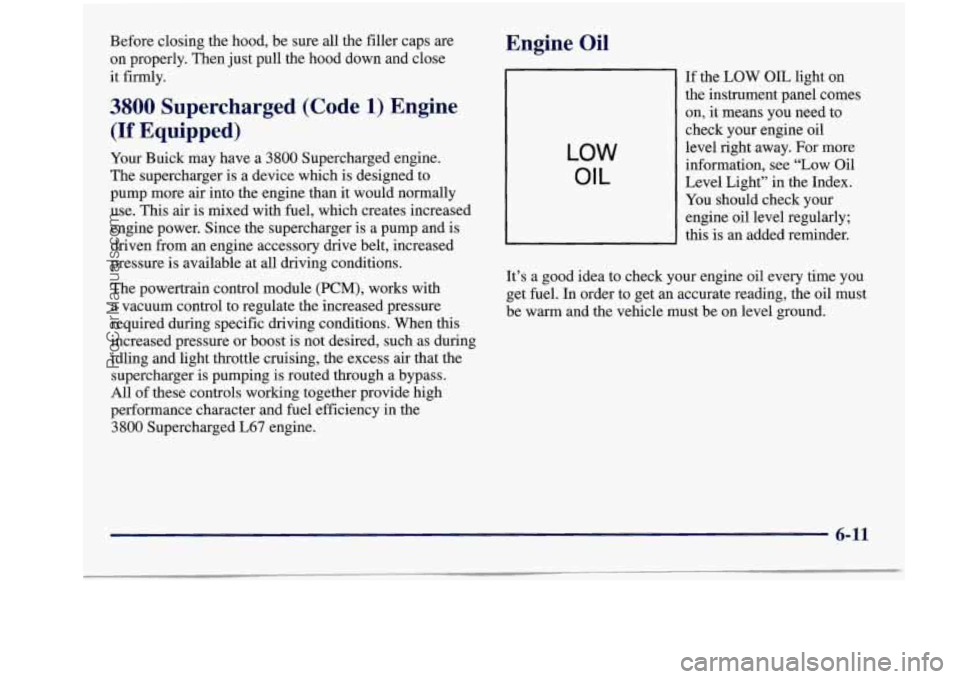
Before closing the hood, be sure all the filler caps are
on properly. Then just pull the hood down and close
it firmly.
3800 Supercharged (Code 1) Engine
(If Equipped)
Your Buick may have a 3800 Supercharged engine.
The supercharger is a device which is designed to
pump more air into the engine than it would normally
use. This air is mixed with fuel, which creates increased
engine power. Since the supercharger is a pump and is
driven from an engine accessory drive belt, increased
pressure is available at all driving conditions.
The powertrain control module
(PCM), works with
a vacuum control to regulate the increased pressure
required during specific driving conditions. When
this
increased pressure or boost is not desired, such as during
idling and light throttle cruising, the excess air that the
supercharger
is pumping is routed through a bypass.
All of these controls working together provide high
performance character and fuel efficiency in the
3800 Supercharged L67 engine.
Engine
I --
LOW
OIL
If the LOW OIL light on
the instrument panel comes on, it means you need to
check your engine oil level right away. For more
information, see
“Low Oil
Level Light” in the Index.
You should check your
engine oil level regularly;
this is an added reminder.
It’s
a good idea to check your engine oil every time you
get fuel. In order to get an accurate reading, the oil must
be warm and the vehicle must be on level ground.
6-11
ProCarManuals.com
Page 321 of 422
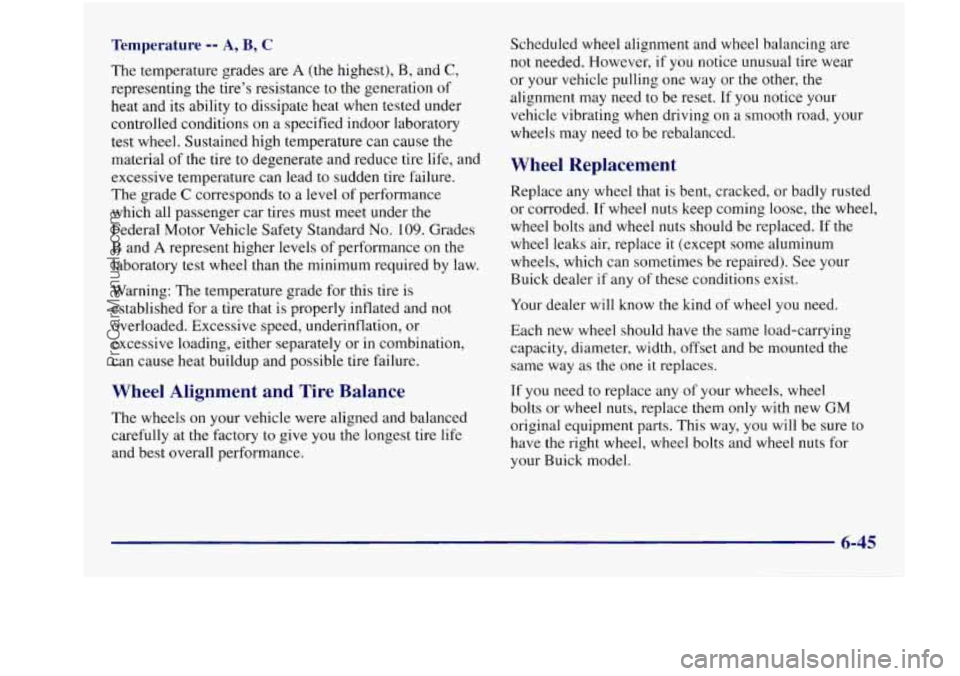
Temperature -- A, B, C
The temperature grades are A (the highest), B, and C,
representing the tire’s resistance to the generation of
heat and its ability to dissipate heat when tested under
controlled conditions on a specified indoor laboratory
test wheel. Sustained high temperature can cause the
material
of the tire to degenerate and reduce tire life, and
excessive temperature can lead to sudden tire failure.
The grade
C corresponds to a level of performance
which all passenger car tires must meet under the
Federal Motor Vehicle Safety Standard
No. 109. Grades
B and
A represent higher levels of performance on the
laboratory test wheel than the minimum required by law.
Warning: The temperature grade for this tire is
established for a tire that is properly inflated and not
overloaded. Excessive speed, underinflation, or
excessive loading, either separately or in combination,
can cause heat buildup and possible tire failure.
Wheel Alignment and Tire Balance
The wheels on your vehicle were aligned and balanced
carefully at the factory to give
you the longest tire life
and best overall performance. Scheduled
wheel alignment and wheel balancing are
not needed. However,
if you notice unusual tire wear
or your vehicle pulling one way or the other, the
alignment
may need to be reset. If you notice your
vehicle vibrating when driving on
a smooth road, your
wheels may need to be rebalanced.
Wheel Replacement
Replace any wheel that is bent, cracked, or badly rusted
or corroded.
If wheel nuts keep coming loose, the wheel,
wheel bolts and wheel nuts should be replaced.
If the
wheel leaks air, replace it (except some aluminum
wheels, which can sometimes be repaired). See your
Buick dealer
if any of these conditions exist.
Your dealer will know the kind of wheel you need.
Each new wheel should have the same load-carrying
capacity, diameter, width, offset and be mounted the
same way as the one it replaces.
If you need to replace any of your wheels, wheel
bolts or wheel nuts, replace them only with new GM
original equipment parts. This way, you will be sure to
have the right wheel, wheel bolts and wheel nuts for
your Buick model.
6-45
ProCarManuals.com